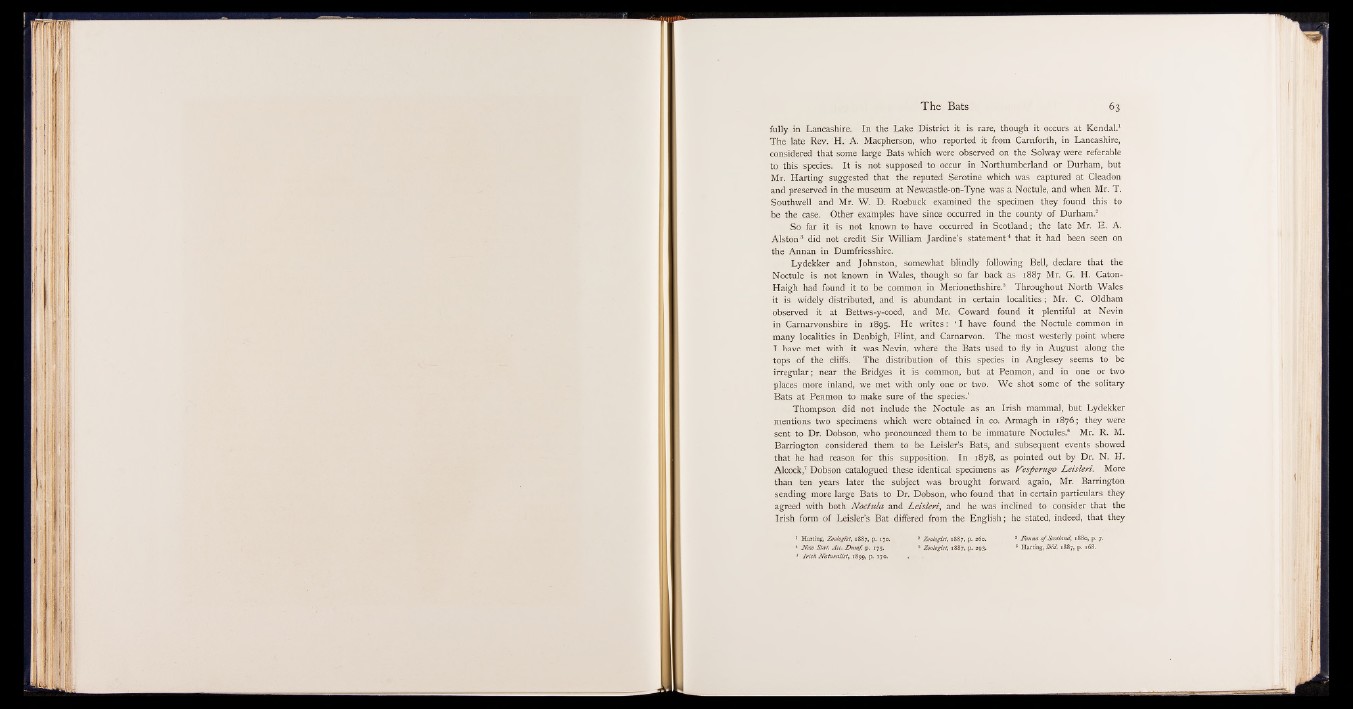
The Bats 63
fully in Lancashire. In the Lake District it is rare, though it occurs at Kendal.1
The late Rev. H. A. Macpherson, who reported it from Carnforth, in Lancashire,
considered that some large Bats which were observed on the Solway were referable
to this species. It is< not supposed to occur in Northumberland or Durham, but
Mr. Harting suggested that the reputed Serotine which was captured at Cleadon
and preserved in the museum at Newcastle-on-Tyne was a Noctule, and when Mr. T.
Southwell and Mr. W. D. Roebuck examined the specimen they found this to
be the case. Other examples have since occurred in the county of Durham.2
So far it is not known to have occurred in Scotland; the late Mr. E. A.
Alston8 did not credit Sir William Jardine’s statement4 that it had been seen on
the Annan in Dumfriesshire.
Lydekker and Johnston, somewhat blindly following Bell, declare that the
Noctule is not known in Wales, though so far back as 1887 Mr. G. H. Caton-
Haigh had found it to be common in Merionethshire.6 Throughout North Wales
it is widely distributed, and is abundant in certain localities; Mr. C. Oldham
observed it at Bettws-y-coed, and Mr. Coward found it plentiful at Nevin
in Carnarvonshire in 1895. He writes: ‘ I have found the Noctule common in
many localities in Denbigh, Flint, and Carnarvon. The most westerly point where
I have met with it was Nevin, where the Bats used to fly in August along the
tops of the cliffs. The distribution of this species in Anglesey seems to be
irregular; near the Bridges it is common, but at Penmon, and in one or two
places more inland, we met with only one or two. We shot some of the solitary
Bats at Penmon to make sure of the species.’
Thompson did not include the Noctule as an Irish mammal, but Lydekker
mentions two specimens which were obtained in co. Armagh in 1876 ; they were
sent to Dr. Dobson, who pronounced them to be immature Noctules.6 Mr. R. M.
Barrington considered them to be Leisler’s Bats, and subsequent events showed
that he had reason for this supposition. In 1878, as pointed out by Dr. N. H.
Alcock,7 Dobson catalogued these identical specimens as Vtsfierugo Leisleri. More
than ten years later the subject was brought forward again, Mr. Barrington
sending more large Bats to Dr. Dobson, who found that in certain particulars they
agreed with both Noctula and Leisleri, and he was inclined to consider that the
Irish form of Leisler’s Bat differed from the English; he stated, indeed, that they
1 Harting, Zoologist, 1887, p. 17.0. 2 Zoologist, 1887, p. 260. 3 Fauna o f Scotland, 1880, p. 7.
4 New Slat. Acc. Dumf. p. 175. * Zoologist, 1887, p. 293. 6 Harting, itbid. 1887, p. 168..'
7 Irish Naturalist, 1899, p. 170. .